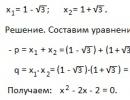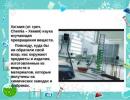Dissociation of water. Ionic product of water pH and pH of solutions. Electrolytic dissociation of water. Ionic product of water. Hydrogen index of the environment. Concept of indicators What ions are formed during the dissociation of water
Pure water, although poor (compared to electrolyte solutions), can conduct electric current. This is caused by the ability of a water molecule to disintegrate (dissociate) into two ions, which are conductors of electric current in pure water (below, dissociation means electrolytic dissociation - disintegration into ions):
pH value(pH) is a value characterizing the activity or concentration of hydrogen ions in solutions. The hydrogen indicator is designated pH. The hydrogen index is numerically equal to the negative decimal logarithm of the activity or concentration of hydrogen ions, expressed in moles per liter: pH=-log[ H+ ] If [ H+ ]>10-7mol/l, [ OH-]<10-7моль/л -среда кислая; рН<7.Если [ H+ ]<10-7 моль/л, [ OH-]>10-7mol/l - alkaline environment; pH>7. Hydrolysis of salts- this is the chemical interaction of salt ions with water ions, leading to the formation of a weak electrolyte. 1). Hydrolysis is not possibleSalt formed by a strong base and a strong acid ( KBr, NaCl, NaNO3), will not undergo hydrolysis, since in this case a weak electrolyte is not formed. pH of such solutions = 7. The reaction of the medium remains neutral. 2). Hydrolysis by cation (only the cation reacts with water). In a salt formed by a weak base and a strong acid
(FeCl2,NH4Cl, Al2(SO4)3,MgSO4)
The cation undergoes hydrolysis:
FeCl2 + HOH<=>Fe(OH)Cl + HCl Fe2+ + 2Cl- + H+ + OH-<=>FeOH+ + 2Cl- + H+
As a result of hydrolysis, a weak electrolyte, H+ ion and other ions are formed. solution pH< 7 (раствор приобретает кислую реакцию). 3). Гидролиз по аниону (в реакцию с водой вступает только анион). Соль, образованная сильным основанием и слабой кислотой
(KClO, K2SiO3, Na2CO3,CH3COONa)
undergoes hydrolysis at the anion, resulting in the formation of a weak electrolyte, hydroxide ion OH- and other ions.
K2SiO3 + HOH<=>KHSiO3 + KOH 2K+ +SiO32- + H+ + OH-<=>НSiO3- + 2K+ + ОН-
The pH of such solutions is > 7 (the solution becomes alkaline). 4). Joint hydrolysis (both the cation and the anion react with water). Salt formed by a weak base and a weak acid
(CH 3COONH 4, (NH 4) 2CO 3, Al2S3),
hydrolyzes both the cation and the anion. As a result, a slightly dissociating base and acid are formed. The pH of solutions of such salts depends on the relative strength of the acid and base. A measure of the strength of an acid and a base is the dissociation constant of the corresponding reagent. The reaction of the medium of these solutions can be neutral, slightly acidic or slightly alkaline:
Al2S3 + 6H2O =>2Al(OH)3v+ 3H2S^
Hydrolysis is a reversible process. Hydrolysis is irreversible if the reaction results in the formation of an insoluble base and (or) a volatile acid
A special case of dissociation (the process of disintegration of larger particles of a substance - ion molecules or radicals - into smaller particles) is electrolytic dissociation, in which neutral molecules of a substance called an electrolyte in solution (as a result of the action of molecules of a polar solvent) disintegrate into charged particles: cations and anions. This explains the ability to conduct current.
It is customary to divide all electrolytes into two groups: weak and strong. Water is a weak electrolyte; the dissociation of water is characterized by a small number of dissociated molecules, since they are quite stable and practically do not disintegrate into ions. Pure (without impurities) water weakly conducts electric current. This is due to the chemical nature of the molecule itself, when positively polarized hydrogen atoms are embedded in the electron shell of a relatively small oxygen atom, which is negatively polarized.
The strength and weakness of electrolytes is characterized (denoted by α, often this value is expressed in% from 0 to 100 or in fractions of a unit from 0 to 1) - the ability to disintegrate into ions, that is, the ratio of the number of disintegrated particles to the number of particles before disintegration. Substances such as acids, salts and bases completely disintegrate into ions under the influence of polar agents. The dissociation of water is accompanied by the decomposition of H2O molecules into the H+ proton and the OH- hydroxyl group. If we present the electrolyte dissociation equation in the form: M=K++A-, then the dissociation of water can be expressed by the equation: H2O↔H++OH-, and the equation with which the degree of water dissociation is calculated can be presented in two forms (via concentration of protons formed or concentration of protons formed hydroxyl groups): α=[H+]/[H2O] or α=[OH-]/[H2O]. Since the value of α is affected not only chemical nature substance, but also the concentration of the solution or its temperature, then it is customary to talk about the apparent (imaginary) degree of dissociation.
The tendency of molecules of weak electrolytes, including water, to disintegrate into ions is largely characterized by the dissociation constant ( special case equilibrium constant), which is usually denoted as Kd. To calculate this value, the law of mass action is applied, which establishes the ratio between the masses of the obtained and initial substances. Electrolytic dissociation of water is the decomposition of the original water molecules into hydrogen protons and a hydroxyl group, therefore it is expressed by the equation: Kd = [H+]. [OH-]/[H2O]. This value for water is constant and depends only on temperature, at a temperature of 25 ° C, Kd = 1.86.10-16.
Knowing molar mass water (18 grams/mol), and also neglecting the concentration of dissociated molecules and taking the mass of 1 dm3 of water as 1000 g, we can calculate the concentration of undissociated molecules in 1 dm3 of water: [H2O] = 1000/18.0153 = 55.51 mol/dm3 . Then from the equation of the dissociation constant one can find the product of the concentrations of protons and hydroxyl groups: [H+].[OH-]=1.86.10-16.55.51=1.10-14. When extracting square root from the obtained value, the concentration of protons (hydrogen ions) is obtained, which determines the acidity of the solution and is equal to the concentration of hydroxyl groups: [H+]=[OH-]=1.10-7.
But in nature, water of such purity does not exist due to the presence of dissolved gases in it or contamination of water with other substances (in fact, water is a solution of various electrolytes), therefore at 25 ° C the concentration of hydrogen protons or the concentration of hydroxyl groups differs from the value of 1.10-7. That is, the acidity of water is due to the occurrence of not only a process such as water dissociation. is the negative logarithm of the hydrogen ion concentration (pH), it is introduced to estimate the acidity or alkalinity of water and aqueous solutions, since numbers with negative powers are difficult to use. For pure water, pH = 7, but since there is no pure water in nature, and the dissociation of water occurs along with the disintegration of other dissolved electrolytes, the pH value can be less or more than 7, that is, for water, practically, pH≠7.
Water- weak amphoteric electrolyte.
The equation for the ionization of water taking into account the hydration of hydrogen ions H + is as follows:
Without taking into account the hydration of H + ions, the water dissociation equation has the form:
![]()
As can be seen from the second equation, the concentrations of hydrogen ions H + and hydroxide ions OH - in water are the same. At 25 o C [H + ] = [OH - ] = 10 -7 mol/l.
The product of the concentrations of hydrogen ions and hydroxide ions is called ionic product of water(KH2O).
K H 2 O = ∙
K H 2 O is a constant value, and at a temperature of 25 o C
K H 2 O = 10 -7 ∙10 -7 = 10 -14
In dilute aqueous solutions of electrolytes, as in water, the product of the concentrations of hydrogen ions H + and hydroxide ions OH - is a constant value at a given temperature. Ionic product water makes it possible for any aqueous solution to calculate the concentration of hydroxide ions OH - if the concentration of hydrogen ions H + is known, and vice versa.
The environment of any aqueous solution can be characterized by the concentration of hydrogen ions H + or hydroxide ions OH -.
There are three types of media in aqueous solutions: neutral, alkaline and acidic.
Neutral environment is a medium in which the concentration of hydrogen ions is equal to the concentration of hydroxide ions:
[H + ] = = 10 -7 mol/l
Acidic environment is a medium in which the concentration of hydrogen ions is greater than the concentration of hydroxide ions:
[H + ] > [OH - ], > 10 -7 mol/l
Alkaline environment is a medium in which the concentration of hydrogen ions is less than the concentration of hydroxide ions:
< , < 10 -7 моль/л
To characterize solution environments, it is convenient to use the so-called pH value (pH).
pH value is called the negative decimal logarithm of the concentration of hydrogen ions: pH = -log.
For example, if = 10 -3 mol/l, then pH = 3, the solution medium is acidic; if [H + ] = 10 -12 mol/l, then pH = 12, the solution medium is alkaline: 
The pH is less than 7, the more acidic the solution. The pH is greater than 7, the greater the alkalinity of the solution.
The relationship between the concentration of H + ions, the pH value and the solution environment is shown in the following diagram:

There are various methods for measuring pH. Qualitatively, the nature of the medium of aqueous solutions of electrolytes is determined using indicators.
Indicators are substances that reversibly change their color depending on the solution environment, i.e., the pH of the solution.
In practice, indicators are used litmus, methyl orange (methyl orange) and phenolphthalein. They change their color in a small pH range: litmus - in the pH range from 5.0 to 8.0; methyl orange - from 3.1 to 4.4 and phenolphthalein - from 8.2 to 10.0.
The change in color of the indicators is shown in the diagram: 
The shaded areas show the range of changes in the color of the indicator.

In addition to the above indicators, a universal indicator is also used, which can be used to approximately determine pH in a wide range from 0 to 14.
The pH value has great value in chemical and biological processes, since depending on the nature of the environment, these processes can occur at different speeds and in different directions.
Therefore, determining the pH of solutions is very important in medicine, science, technology, agriculture. Changing the pH of blood or gastric juice is a diagnostic test in medicine. Deviations of pH from normal values, even by 0.01 units, indicate pathological processes in the body. The constancy of the concentrations of hydrogen ions H + is one of the important constants of the internal environment of living organisms.
Thus, with normal acidity, gastric juice has a pH of 1.7; The pH of human blood is 7.4; saliva - 6.9. Each enzyme functions at a certain pH value: blood catalase at pH 7 gastric juice pepsin - at pH 1.5-2; etc.
Conducts electricity very poorly, but still has some measurable electrical conductivity, co which is explained by a slight dissociation of water into hydrogen and hydroxyl ions:
H2O ⇄ H + OH’
Based on the electrical conductivity of pure water, the concentration of hydrogen ions and hydroxyl ions in water can be calculated. It turns out to be equal to 10 -7 G-ion /l.
Applying the law of mass action to the dissociation of water, we can write:
Let's rewrite this equation as follows:
[OH'] = [H 2 O]K
Since there is very little water, the concentration of undissociated H 2 O molecules not only in water, but also in any dilute aqueous solution can be considered a constant value. Therefore, replacing [H 2 O] K with the new constant KH 2 O, we will have:
[H] [OH’] = TO H2O
The resulting equation shows that for water and dilute aqueous solutions at a constant temperature, the product of the concentrations of hydrogen and hydroxyl ions is a constant value. This constant is called the ionic product of water. Its numerical value can be easily obtained by substituting the concentrations of hydrogen and hydroxyl ions into the last equation
TO H2O = 10 -7 10 -7 = 10 -14
Solutions in which the concentration of hydrogen and the concentration of hydroxyl ions are the same and equal to every 10 —7 g-ion/l are called neutral solutions. In acidic solutions more concentration hydrogen ions, in alkaline ones - the concentration of hydroxyl ions. But whatever the reaction of the solution, the product of the concentrations of H and OH' ions must remain constant.
If, for example, enough acid is added to pure water so that the concentration of hydrogen ions increases to 10 -3, the concentration of hydroxyl ions will have to decrease so that the product [H] [OH'] remains equal to 10 -14. Therefore, in this solution the concentration of hydroxyl ions will be:
10 -14: 10 -3 = 10 -11
On the contrary, if you add alkali to water and thereby increase the concentration of hydroxyl ions, for example, to 10 -5, the concentration of hydrogen ions will become equal to:
10 -14: 10 -5 = 10 -9
You are reading an article on the topic Dissociation of water






